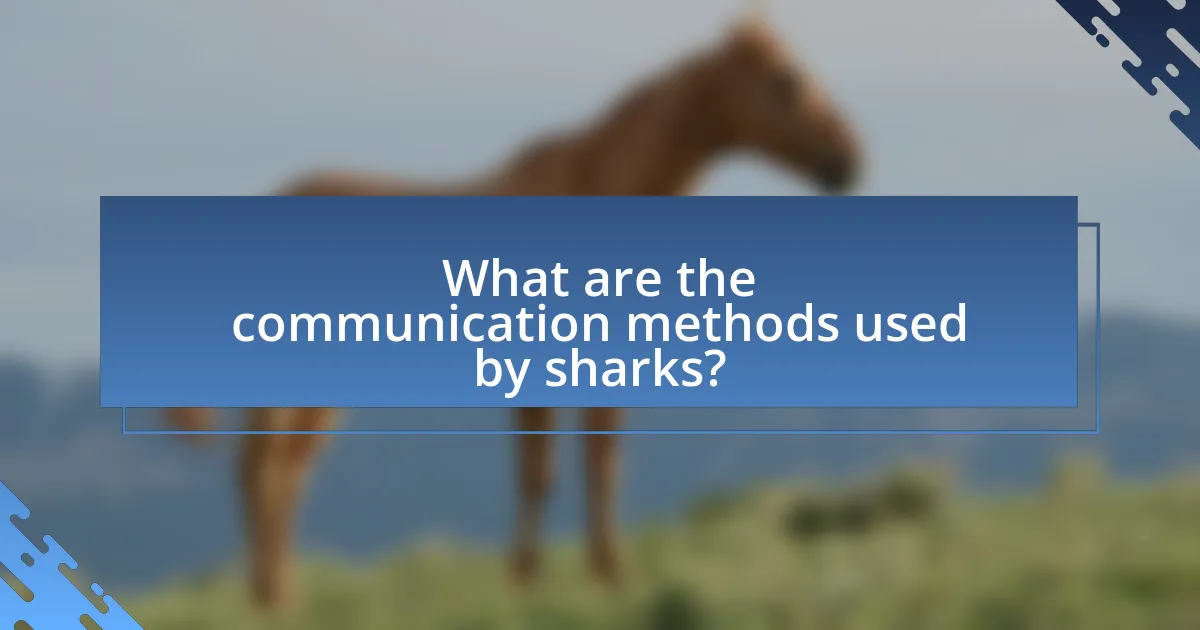Shark communication methods encompass a range of techniques including body language, electroreception, and chemical signals. Sharks utilize body postures and movements to convey aggression, submission, or readiness to mate, while electroreception helps them detect electric fields from other animals. Additionally, they produce non-vocal sounds through mechanisms such as grinding their teeth and using their swim bladders, which serve various communicative purposes. Understanding these communication methods is crucial for enhancing conservation efforts and improving human interactions with sharks, as it provides insights into their behavior, social structures, and stress responses.

What are the communication methods used by sharks?
Sharks primarily communicate through body language, electroreception, and chemical signals. Body language includes postures and movements that convey aggression, submission, or readiness to mate. For example, a shark may arch its back or display its fins to signal dominance. Electroreception allows sharks to detect the electric fields generated by other animals, aiding in locating prey and communicating with conspecifics. Additionally, sharks release pheromones into the water, which can indicate reproductive status or territorial boundaries. These methods are essential for their survival and social interactions within their environment.
How do sharks vocalize their communication?
Sharks do not vocalize in the traditional sense like many other animals; instead, they communicate primarily through body language and non-vocal sounds. Research indicates that sharks can produce sounds by moving air through their gills or by using their bodies to create vibrations in the water, which can convey information to other sharks. For example, studies have shown that certain species, such as the great white shark, can produce low-frequency sounds that may serve as a form of communication during mating or territorial displays.
What types of sounds do sharks produce?
Sharks produce a variety of sounds, primarily through mechanisms such as grinding their teeth, expelling air, and using their bodies to create vibrations. These sounds can include low-frequency noises, clicks, and grunts, which are often used for communication and navigation. Research indicates that these vocalizations can serve different purposes, such as signaling distress or establishing territory. For instance, studies have shown that certain species of sharks, like the lemon shark, can produce distinct sounds that are recognized by other sharks, facilitating social interactions.
How do these vocalizations vary among different shark species?
Shark vocalizations vary significantly among different species, with some producing sounds through specialized structures while others rely on body language. For instance, the nurse shark is known to produce low-frequency sounds by vibrating its swim bladder, while the great white shark primarily communicates through body postures and movements rather than vocalizations. Research indicates that vocalization patterns can also differ based on environmental factors and social interactions, highlighting the adaptability of these species in their communication methods.
What role does body language play in shark communication?
Body language plays a crucial role in shark communication by conveying information about their intentions, emotions, and social interactions. Sharks utilize various body postures, movements, and fin positions to signal aggression, submission, or curiosity to other sharks. For instance, a shark that arches its back and raises its dorsal fin may be displaying aggression, while a relaxed posture with a lowered fin indicates a non-threatening demeanor. Research has shown that these non-verbal cues are essential for maintaining social hierarchies and avoiding conflicts among sharks, as evidenced by observations of their interactions in natural habitats.
What specific body movements do sharks use to convey messages?
Sharks use specific body movements such as swimming patterns, postural changes, and fin positioning to convey messages. For instance, a shark may exhibit a slow, deliberate swimming motion to signal calmness or non-aggression, while rapid movements can indicate excitement or aggression. Additionally, the positioning of their dorsal fin can communicate their mood; a raised fin often signifies alertness or readiness to engage, whereas a lowered fin may indicate relaxation or submission. These movements are essential for social interactions and establishing dominance within their species, as evidenced by observations of various shark species in their natural habitats.
How does body posture affect shark interactions?
Body posture significantly influences shark interactions by conveying information about a shark’s intentions and emotional state. For instance, a shark that swims with a horizontal body posture typically indicates a relaxed state, while an upright or vertical posture may signal aggression or curiosity. Research has shown that sharks use body language, including posture, to communicate with each other and assess threats or opportunities in their environment. This non-verbal communication is crucial for social interactions, mating behaviors, and territorial disputes among sharks.
Why is understanding shark communication important?
Understanding shark communication is important because it enhances our ability to interact with and conserve these species effectively. By deciphering their vocalizations and body language, researchers can gain insights into shark behavior, social structures, and stress responses. For instance, studies have shown that specific sounds and body movements can indicate aggression or mating readiness, which are crucial for managing shark populations and mitigating human-shark interactions. This knowledge is vital for developing conservation strategies and ensuring the safety of both sharks and humans in shared environments.
How can knowledge of shark communication improve conservation efforts?
Knowledge of shark communication can significantly enhance conservation efforts by enabling more effective management strategies that consider their social behaviors and interactions. Understanding how sharks use vocalizations and body language to communicate can inform researchers and conservationists about their social structures, mating behaviors, and stress responses. For instance, studies have shown that certain vocalizations can indicate distress or aggression, which can be critical information for developing strategies to minimize human-shark interactions and protect vulnerable species. Additionally, recognizing the importance of communication in their natural habitats can lead to the establishment of marine protected areas that support their social dynamics, ultimately contributing to healthier shark populations and ecosystems.
What implications does shark communication have for human interactions?
Shark communication has significant implications for human interactions, particularly in understanding behavior and safety in marine environments. By studying how sharks use vocalizations and body language, humans can better interpret shark behavior, which may reduce the likelihood of negative encounters. For instance, research indicates that sharks communicate through body postures and movements, signaling aggression or submission, which can inform divers and swimmers about their proximity to potentially dangerous situations. Understanding these signals can lead to improved safety protocols and conservation efforts, as humans learn to respect shark habitats and behaviors, ultimately fostering a more harmonious coexistence.

What are the specific vocalizations of sharks?
Sharks do not produce vocalizations in the way many other animals do, as they lack vocal cords. Instead, they communicate through body language and other non-vocal sounds, such as the noise created by their movement through water. Research indicates that sharks can generate sounds through the movement of their bodies and fins, which can create vibrations that may be perceived by other sharks. Additionally, some species may produce low-frequency sounds by grinding their teeth or through other mechanical means. These methods serve as a form of communication, particularly during mating or territorial disputes.
How do sharks produce sounds underwater?
Sharks produce sounds underwater primarily through a mechanism called “stridulation,” which involves rubbing together specific structures in their bodies, such as their teeth or cartilage. This method allows sharks to create a variety of sounds, including clicks and grunts, which can serve different purposes, such as communication or navigation. Research indicates that these vocalizations can be used to signal distress, attract mates, or establish territory, highlighting the importance of sound in shark behavior and interaction.
What anatomical features enable sound production in sharks?
Sharks produce sound primarily through specialized structures in their bodies, including their swim bladders and muscles. The swim bladder acts as a resonating chamber, amplifying sounds generated by the contraction of surrounding muscles. Additionally, sharks can create sounds by grinding their teeth or using their jaws, which can produce clicks or other noises. Research indicates that these sounds play a role in communication and social interactions among sharks, highlighting the importance of these anatomical features in their vocalizations.
How does the environment influence shark vocalizations?
The environment significantly influences shark vocalizations by affecting the acoustic properties of their habitat. Factors such as water temperature, salinity, and ambient noise levels can alter how sound travels, which in turn impacts the effectiveness of vocalizations used for communication. For instance, warmer water can enhance sound transmission, allowing sharks to communicate over greater distances. Additionally, areas with high levels of background noise, such as near shipping lanes, may lead sharks to modify their vocalizations to ensure their signals are heard. Research indicates that these adaptations are crucial for social interactions and hunting strategies among different shark species.
What are the meanings behind different shark sounds?
Shark sounds serve various communicative purposes, including signaling distress, aggression, or mating readiness. Research indicates that sharks produce sounds through mechanisms such as grinding their teeth or using their swim bladders, which can convey specific messages. For instance, low-frequency sounds may indicate stress or discomfort, while higher-frequency sounds can be associated with aggression or territorial behavior. Studies have shown that these vocalizations play a crucial role in social interactions among sharks, helping them navigate their environment and establish social hierarchies.
How do researchers interpret shark vocalizations?
Researchers interpret shark vocalizations by analyzing the frequency, duration, and context of the sounds produced by sharks. These vocalizations, which can include clicks, grunts, and other noises, are believed to serve various purposes such as communication during mating, signaling distress, or establishing territory. Studies have shown that specific vocal patterns correlate with particular behaviors, indicating that sharks use sound as a form of social interaction. For instance, research published in the journal “Marine Biology” by authors such as H. A. M. de Jong and colleagues demonstrates that certain vocalizations are associated with aggressive encounters, providing insight into their social dynamics.
What are the contexts in which sharks vocalize?
Sharks vocalize primarily in contexts related to communication during social interactions, mating behaviors, and territorial disputes. Research indicates that sharks produce sounds through mechanisms such as grinding their teeth or using their swim bladders, which can serve to establish dominance or attract mates. For instance, during mating season, male sharks may vocalize to signal their presence to females, while aggressive encounters with other sharks can lead to vocalizations that assert territorial claims. These vocalizations are crucial for their social structure and reproductive success, highlighting the importance of sound in their behavioral repertoire.

How does body language enhance shark communication?
Body language enhances shark communication by allowing these animals to convey information about their intentions, emotions, and social status without vocalizations. Sharks utilize various body movements, such as changes in posture, swimming patterns, and fin positioning, to signal aggression, submission, or mating readiness. For instance, a shark that arches its back and raises its dorsal fin may be displaying dominance or aggression, while a relaxed posture with a lowered fin can indicate submission or a non-threatening state. Research has shown that these non-verbal cues are crucial for social interactions among sharks, as they help establish hierarchies and facilitate mating behaviors, thereby improving their chances of survival and reproductive success.
What are the key body language signals used by sharks?
Sharks primarily use body language signals such as posturing, fin positioning, and swimming patterns to communicate. For instance, a shark that arches its back or raises its dorsal fin may be displaying aggression or dominance, while a relaxed posture with a lowered fin indicates calmness. Additionally, rapid swimming or erratic movements can signal excitement or distress. These behaviors are observed in various shark species and are crucial for social interactions, mating rituals, and territorial displays, reinforcing the importance of body language in their communication methods.
How do fin movements indicate aggression or submission?
Fin movements in sharks indicate aggression or submission through specific postures and motions. Aggressive sharks often display raised or rigid fins, signaling dominance and readiness to attack, while submissive sharks tend to lower their fins or keep them close to their bodies, indicating a non-threatening posture. Research has shown that these behaviors are part of their social interactions, with fin positioning serving as visual cues to other sharks about their intentions, thus facilitating communication and reducing potential conflicts.
What does tail position reveal about a shark’s mood?
The tail position of a shark indicates its mood, with specific orientations reflecting different emotional states. For instance, a shark with its tail held high is often exhibiting excitement or aggression, while a tail that is lowered may suggest a more relaxed or neutral state. Research has shown that tail movements are integral to a shark’s communication, as they can signal readiness to attack or a desire to retreat, thus providing insight into the animal’s behavioral intentions.
How do environmental factors affect shark body language?
Environmental factors significantly influence shark body language by altering their behavior and communication signals. For instance, water temperature affects metabolic rates, which can lead to changes in swimming patterns and aggression levels. Additionally, visibility conditions, such as murky water, can cause sharks to rely more on body language rather than visual cues, leading to more pronounced movements to communicate their intentions. Research indicates that sharks exhibit different body postures and movements in response to varying levels of stress induced by environmental changes, such as noise pollution or the presence of boats, which can further modify their social interactions.
What role does water temperature play in shark behavior?
Water temperature significantly influences shark behavior by affecting their metabolic rates, movement patterns, and hunting strategies. Sharks are ectothermic animals, meaning their body temperature is regulated by the surrounding water, which directly impacts their activity levels; warmer waters generally increase their metabolism, leading to more active hunting and social behaviors. Research indicates that species like the great white shark exhibit migratory patterns that align with temperature changes, moving to warmer waters for breeding and feeding. Additionally, studies have shown that certain shark species prefer specific temperature ranges, which can dictate their distribution and interactions with other marine life.
How does visibility impact shark communication through body language?
Visibility significantly impacts shark communication through body language by influencing their ability to perceive and interpret visual signals from other sharks. In clear water, sharks can effectively use body postures, fin movements, and swimming patterns to convey aggression, submission, or mating readiness. For instance, a shark displaying a lowered pectoral fin may signal submission, while an upright posture can indicate aggression. Research indicates that in murky waters, these visual cues become less effective, leading to increased reliance on other senses, such as electroreception, to communicate and navigate. This reliance on alternative communication methods can alter social interactions and behaviors among sharks, as visual signals are crucial for establishing social hierarchies and mating displays.
What practical insights can we gain from understanding shark communication?
Understanding shark communication provides practical insights into their behavior, which can enhance conservation efforts and improve human-shark interactions. By studying vocalizations and body language, researchers have identified specific signals that indicate aggression, mating readiness, or stress. For instance, the presence of certain body postures, such as arching the back or rapid tail movements, can signal a shark’s readiness to attack or defend itself. This knowledge allows divers and fishermen to recognize warning signs, potentially reducing dangerous encounters. Additionally, understanding these communication methods can inform habitat protection strategies, as preserving areas where sharks exhibit social behaviors can contribute to their population stability.
How can divers and researchers safely interact with sharks based on their communication methods?
Divers and researchers can safely interact with sharks by understanding and interpreting their communication methods, which include vocalizations and body language. Recognizing signs of aggression, such as rapid tail movements or a lowered pectoral fin, allows divers to avoid provoking the sharks. Additionally, maintaining a calm demeanor and avoiding sudden movements can help prevent stress in sharks, as they are sensitive to changes in their environment. Studies have shown that sharks can respond positively to non-threatening behaviors, such as slow, deliberate movements and maintaining eye contact, which can foster a sense of safety and reduce the likelihood of aggressive encounters.
What best practices should be followed to respect shark communication in their habitats?
To respect shark communication in their habitats, individuals should minimize noise pollution and avoid disturbing their natural behaviors. Research indicates that sharks rely on both vocalizations and body language for communication, making it crucial to maintain a quiet environment to prevent stress and disruption. Additionally, divers and boaters should avoid sudden movements and maintain a safe distance from sharks to allow them to communicate effectively without interference. Studies have shown that disturbances can alter shark behavior, impacting their social interactions and overall health.


